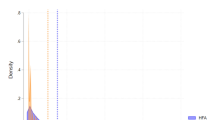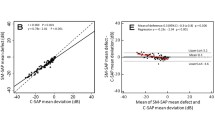Abstract
The various stimulus parameters offered by two standard automated projection perimeters [Humphrey Field Analyser 630 (HFA) and Octopus 2011, namely, stimulus size and location and the interaction of adaptation level and stimulus duration, were compared in a sample of 20 patients attending a glaucoma clinic using the visual field indices mean defect (MD), loss variance (LV), short-term fluctuation (SF) and corrected loss variance (CLV). LV and SF were greater with Octopus program 32 compared with Octopus program G1 (P < 0.02). No difference in the indices was found between stimulus sizes I and III for HFA program 30-2. MD was greater for program 30-2 compared with program 32 (P < 0.002) when expressed in terms of log (L/ΔL) whereas LV (P < 0.02) and SF (P < 0.02) were greater for program 32. All differences were considered to be negligible in the clinical sense.
Similar content being viewed by others
References
Atchison DA (1987) Effect of defocus on visual field measurement. Ophthalmic Physiol Opt 7:259–265
Aulhorn E, Harms H (1972) Visual perimetry. In: Jameson D, Hurvich LM (eds) Handbook of sensory physiology, vol VII/4. Springer, Berlin Heidelberg New York
Bebie H (1985) Computerised techniques of visual field analysis. In: Drance SM, Anderson D (eds) Automatic perimetry in glaucoma. A practical guide. Grune and Stratton, Orlando
Bebie H, Fankhauser F, Spahr J (1976) Static perimetry: accuracy & fluctuations. Acta Ophthalmol 54:339–348
Bland JM, Altman DG (1986) Statistical methods for assessing agreement between two methods of clinical measurement. Lancet 1:307–310
Brenton RS, Argus WA (1987) Fluctuations on the Humphrey and Octopus perimeters. Invest Ophthalmol Vis Sci 28:767–771
Brenton RS, Phelps CD (1986) The normal visual field on the Humphrey Field Analyser. Ophthalmologica 193:56–74
Caprioli J, Sears M (1987) Patterns of early visual field loss in glaucoma. Doc Ophthalmol Proc Ser 49:307–316
Choplin NT, Sherwood MB, Spaeth GL (1990) The effect of stimulus size on the measured threshold values in automated perimetry. Ophthalmology 97:371–374
Crosswell HH, Stewart WC, Cascairo MA, Hunt HH (1991) The effect of background intensity on the components of fluctuation as determined by threshold-related automated perimetry. Graefe's Arch Clin Exp Ophthalmol 229:119–122
Dannheim F (1987) First experiences with the new Octopus G1 program in chronic simple glaucoma. Doc Ophthalmol Proc Ser 49:321–328
Dannheim F, Drance SM (1974) Psychovisual disturbances in glaucoma. A study of temporal and spatial summation. Arch Ophthalmol 91:463–468
Fankhauser F (1979) Problems related to the design of automatic perimeters. Doc Ophthalmol 47:89–138
Fankhauser F, Bebie H (1979) Threshold fluctuations, interpolations and spatial resolution in perimetry. Doc Ophthalmol Proc Ser 19:295–309
Fankhauser F, Schmidt T (1958) Die Untersuchung der räumlichen Summation mit stehender und bewegter Reizmarke nach der Methode der quantitativen Lichtsinnperimetrie. Ophthalmologica 135:660–666
Fankhauser F, Schmidt T (1960) Die optimalen Bedingungen für die Untersuchung der rümlichen Summation mit stehender Reizmarke nach der quantitativen Lichtsinnperimetrie. Ophthalmologica 139:409–423
Fankhauser F, Bebie H, Flammer J (1988) Threshold fluctuations in the Humphrey Field Analyser and in the Octopus automated perimeter. Invest Ophthalmol Vis Sci 29:1466
Flammer J (1986) The concept of visual field indices. Graefe's Arch Clin Exp Ophthalmol 224:389–392
Gilpin LB, Stewart WC, Hunt HH, Broom CD (1990) Threshold variability using different Goldmann stimulus sizes. Acta Ophthalmol 68:674–676
Gloor B, Gloor E (1986) Die Erfassbarkeit glaukomatoser Gesichtsfeldausfälle mit dem automatischen Perimeter Oktopus. Ein Vergleich zwischen Programm G1 und den Programmen 31 und 32 und deren Kombination. Klin Monatsbl Augenheilkd 188:33–38
Goldstick BI, Weinreb RN (1987) The effect of refractive error on Octopus global analysis program G1. Invest Ophthalmol Vis Sci [Suppl] 28:270
Grainer E, Kontic D, Krieglstein GK (1981) Die computerperimetrische Darstellung glaukomatoser Gesichtsfelddefekte in Abhängigkeit von der Stimulusgrosse. Ophthalmologica 183:162–167
Greve EL (1973) Single and multiple stimulus static perimetry in glaucoma; the two phases of perimetry. Doc Ophthalmol 36:1–355
Greve EL (1979) Visual fields, glaucoma and cataract. Doc Ophthalmol Proc Ser 22:79–88
Heijl A (1977) Time changes of contrast thresholds during automatic perimetry. Acta Ophthalmol 55:696–708
Heijl A, Drance SM (1983) Changes in differential threshold in patients with glaucoma during prolonged perimetry. Br J Ophthalmo; 67:512–516
Heiji A, Lindgren G, Olsson J (1987) A package for the statistical analysis of visual field. Doc Ophthalmol Proc Ser 49:153–168
Heuer DK, Anderson DR, Feuer WJ, Gressel MG (1987) The influence of refraction accuracy on automated perimetric threshold measurements. Ophthalmology 94:1550–1553
Heuer DK, Anderson DR, Feuer WJ, Knighton RW, Gressel MG, Fantes FE (1987) The influence of simulated media opacities on threshold measurements. Doc Ophthalmol Proc Ser 49:15–22
Heuer DK, Anderson DR, Feuer WJ, Knighton RW, Gressel MG (1988) The influence of simulated light scattering on automated perimetric threshold measurements. Arch Ophthalmol 106:1247–1251
Heuer DK, Anderson DR, Feuer WJ, Gressel MG (1989) The influence of decreased retinal illumination on automated perimetric threshold measurements. Am J Ophthalmol 108:643–650
Hoskins HD, Migliazzo C (1985) Development of a visual field screening test using a Humphrey visual field Analyser. Doc Ophthalmol Proc Ser 42:85–90
Humphrey Owner's Manual. Allergan Humphrey. San Leandro
Keltner JL (1979) Comments on automated perimetry papers. Ophthalmology 86:1317–1319
Keltner JL, Johnson CA (1986) Is the ideal automated perimeter available? Editorial. Arch Ophthalmol 104:347–349
King D, Drance SM, Douglas GR, Wijsman K (1986) The detection of paracentral scotomas with varying grids in computed perimetry. Arch Ophthalmol 104:524–525
Langerhorst CT (1988) Automated perimetry in glaucoma. Fluctuation behaviour and general and local reduction of sensitivity. Kugler and Ghedini, Amsterdam
Lewis RA, Johnson CA, Keltner JL, Labermeier PK (1986) Variability of quantitative automated perimetry in normal observers. Ophthalmology 93:878–881
Lustgarten JS, Marx MS, Podos SM, Bodis-Wollner I, Campeas D, Serle JB (1990) Contrast sensitivity and computerized perimetry in early detection of glaucomatous change. Clin Vis Sci 5:407–413
Mills RP, Hopp RH, Drance SM (1986) Comparison of quantitative testing with the Octopus, Humphrey and Tilbingen perimeters. Am J Ophthalmol 102:496–504
Mogil LG, Abramovsky-Kaplan I, Rosenthal JS, Podos SM (1985) Comparison of Goldmann, Humphrey and Octopus perimeters in glaucoma. Invest Ophthalmol Vis Sci [Suppl] 26:225
Radius R (1978) Perimetry in cataract patients. Arch Ophthalmol 96:1574–1579
Rutihauser C, Flammer J, Haas A (1989) The distribution of normal values in automated perimetry. Graefe's Arch Clin Exp Ophthalmol 227:513–517
Starita RJ, Fellman RL, Lynn JR (1987) Static automated perimetry: background luminance and global visual field indices in the quantification of normal, suspect and glaucomatous visual fields. Invest Ophthalmol Vis Sci [Suppl] 28:269
Sues FE, Verriest G (1987) Inter- and intra-individual sensitivity variations with manual and automated static perimeters. Ophthalmologica 195:209–214
Van den Berg TJTP, Van Spronson R, Van Veenendaal WG, Bakker D (1985) Psychophysics of intensity discrimination in relation to defect volume examination on the Scoperimeter. Doc Ophthalmol Proc Ser 42:147–151
Weber J, Kosel J (1986) Glaukomperimetrie — die Optimierung von Prüfpunktrastern mit einem Informationsindex. Klin Monatsbl Augenheilkd 189:110–117
Weinreb RN, Perlman JP (1986) The effects of refractive correction on automated perimetric thresholds. Am J Ophthalmol 101:706–709
Werner EB, Adelson AA, Krupin TP (1988) Effect of patient experience on the results of automated perimetry in clinically stable glaucoma patients. Ophthalmology 95:764–767
Werner EB, Krupin T, Adelson A, Feitl ME (1990) Effect of patient experience on the results of automated perimetry in glaucoma suspect patients. Ophthalmology 97:44–48
Wild JM, Wood JM, Flanagan JG, Good PA, Crews SJ (1986) The interpretation of the differential light threshold in the central visual field. Doc Ophthalmol 62:191–202
Wild JM, Wood JM, Flanagan JG (1986) Spatial summation and the cortical representation of perimetric profiles. Ophthalmologica 195:88–96
Wild JM, Dengler-Harles M, Searle AET, O'Neill EC, Crews SJ (1989) The influence of the learning effect on automated perimetry in patients with suspected glaucoma. Acta Ophthalmol 67:537–545
Wilensky JT, Mermelstein JR, Siegel HG (1986) The use of different sized stimuli on automated perimetry. Am J Ophthalmol 101:710–713
Wood JM, Wild JM, Drasdo N, Crews SJ (1986) Perimetric profiles and cortical representation. Ophthalmic Res 18:301–308
Wood JM, Wild JM, Good PA, Crews SJ (1986) Stimulus investigative range in the perimetry of retinitis pigmentosa: some preliminary findings. Doc Ophthalmol 63:287–302
Zalta A (1991) Use of a central 10° field and size V stimulus to evaluate and monitor small central islands of vision in end stage glaucoma. Br J Ophthalmol 75:151–154
Zalta A, Burchfield JC (1990) Detecting early glaucomatous field defects with the size I stimulus and Statpac. Br J Ophthalmol 74: 289–293
Author information
Authors and Affiliations
Rights and permissions
About this article
Cite this article
Dengler-Harles, M., Wild, J.M., Cole, M.D. et al. The influence of stimulus parameters on the visual field indices by automated projection perimetry. Graefe's Arch Clin Exp Ophthalmol 231, 337–343 (1993). https://doi.org/10.1007/BF00919030
Received:
Accepted:
Issue Date:
DOI: https://doi.org/10.1007/BF00919030




